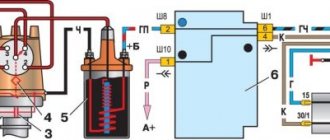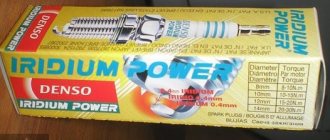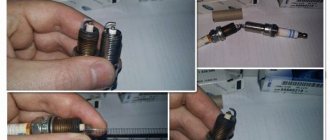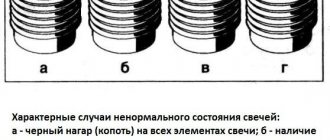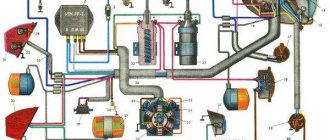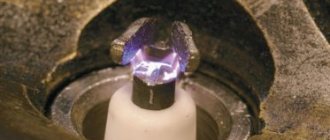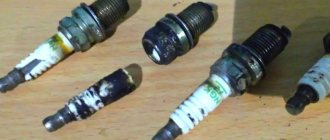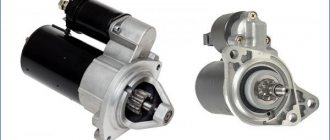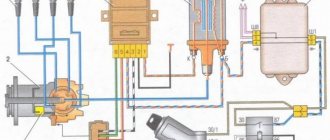The stability of the car engine directly depends on the serviceability of the spark plugs. If the engine begins to consume more fuel, troits, “jerks” or stalls at idle, it may be time to replace them. But in order not to waste money buying new spark plugs, it is better to first diagnose the old ones. In some cases they can be successfully restored.
In fact, there is no difference in when to replace. If the engine is running smoothly, let the spark plugs reach their full service life. If there are obvious interruptions in its operation, you should not delay in diagnosing them.
Working life of spark plugs
The average spark plug is designed for 20-30 thousand kilometers, or a year of operation. During this time, during normal engine operation, its electrodes do not have time to burn out, i.e. it formally remains working, provided that its insulator is not damaged and does not break through to ground.
You will learn about the most anticipated crossovers of this year here.
Are you going on a long trip to unfamiliar places? Don't forget to take your navigator with you. Here you will learn how to choose the right car navigator.
There are two opinions among car enthusiasts about when to change spark plugs. Some argue that it is better to do this before the onset of cold weather, so that in cold weather the engine starts more easily, while others, on the contrary, advise replacing it in the spring, explaining that during the winter a thick layer of soot settles and accumulates on the spark plugs due to the condensation that forms .
Selection of candles
When purchasing candle products, pay attention to the main features:
- Heat number is the indicator at which the mixture with a hot electrode begins to ignite. That is, ignition occurs not from a spark, but from the heating temperature of the electrode.
- Spark gap is the interval covering the gap between the central and grounding elements. It is not recommended to bend or press it. If the parts are worn out, it is better to replace them.
- Temperature Range . It is determined by heating the working section of the spark plug and is 900° (from 500°) without going beyond the specified frame. Below 500° leads to problems, distorting spark formation. Above 900° leads to glow ignition. This is where the terms “cold” and “hot” candles arise.
- Thermal performance . Directly related to the heat and operation of the engine. Hot spark plugs self-clean from carbon deposits at high engine speeds (as mentioned above). Cold - self-cleaning at low temperatures, but high load limits on the power unit. It is not recommended to use as the candle becomes unsuitable for use.
So, the spark plug resource provides up to 30 thousand kilometers , but depends on their operating conditions.
Iridium
Made of iridium alloy with a thin central electrode with a melting point of 2450°C . Wear resistance is higher than platinum, which makes it possible to create a central electrode with a cross-section of 0.4 mm and obtain a strong spark with better ignition in the chamber.
Performance characteristics of iridium spark plug
Operational indicators give:
- Mileage 100 thousand kilometers.
- Fast ignition, even with a lean mixture.
- Low voltage requirement with improved ignition.
- Increased power up to 3% with reduced gasoline consumption up to 7%.
- Smooth start of movement in cold weather, low exhaust gas toxicity. Iridium products are ahead of the performance indicators of nickel or platinum spark plugs, including 2-3 times in cost.
The secret of the advantage lies in laser welding of electrodes. Electrical conductivity allows the production of electrodes of small diameters relative to copper or platinum metal. This promotes better combustion of gasoline in all operating modes of the car. At the same time, precise clearance is ensured to prevent spark loss.
The disadvantages, in addition to cost, include the low demand for use on low-power engines.
What spark plugs can be restored?
Diagnostics of spark plugs consists of a visual inspection of the condition of their central and side (grounding) electrodes, insulator, and contact rod. If the spark plug's electrodes and contact rod do not have obvious signs of burnout or corrosion, and the insulator is not damaged, such a spark plug can serve for quite a long time if it is put in order. In a pinch, it can be quite useful as a spare. If the candle has the listed symptoms, it is better to replace it.
Why is performance lost?
When natural wear and tear occurs, then, of course, they need to be thrown away and new ones installed. But sometimes the candles are simply dirty and are still in good condition.
This happens for the following reasons:
- The engine operated for a long time in critical conditions: a rich mixture at a low temperature. As a result, the insulator was completely smoked.
- Engine oil has entered the combustion chamber. The fault was corrected, but the spark plugs were covered with combustion products.
- Starting the engine was unsuccessful. Unburned fuel has created a conductive layer on the insulator; there is no spark.
The exact cause can be quickly determined. For this purpose, there are color tables that show faulty spark plugs and the type of fault. You can easily find such information on the Internet.
Ultrasonic cleaning of spark plugs
Ultrasonic cleaning involves removing carbon and deposits on the electrodes by placing the spark plug skirt in a special bath with a cleaning liquid and exposing it to ultrasound. This method has long been used at service stations to clean injectors. Its efficiency is quite high, but the cost of such services often exceeds the cost of a new set of candles.
Sandblasting
The effectiveness of the method of cleaning various parts using sand, which is supplied to the product with a strong jet of compressed air, was known even before Soviet times. Therefore, it is not surprising that domestic innovators used and still use this method to clean spark plugs from carbon deposits.
In this case, you need to act as follows:
- carefully bend the side electrodes;
- place the candle under a stream of abrasive material;
- we get rid of carbon deposits by cleaning from different sides and corners;
- carefully restore the interelectrode gap, which in working condition should be from 0.6 to 1.5 mm, depending on the type of spark plug.
Attention!!!
This method works most effectively with single-electrode spark plugs with open access to the protective casing of the central electrode. In other cases, such access will have to be ensured by first bending the electrodes. Experts consider the advantages of this option to be availability, fairly low cost and complete restoration of consumables’ functionality (blue spark and no breakdowns).
Mechanical cleaning
Mechanical cleaning can be carried out in two ways. In the first case, sandblasting equipment is used. The spark plug is mounted on a special bracket, and its working elements are exposed to a stream of air containing tiny particles of sand or other abrasive substances. You can also find similar equipment at service stations, but here again it all comes down to price.
Mechanical cleaning can also be done on your own. To do this, you will need a special brush with thin metal bristles. The candle is first soaked for 30-40 minutes in gasoline, kerosene, acetone or carburetor cleaning fluid, and then carefully cleaned with a toothpick and the aforementioned brush. The disadvantage of this method is the high probability of violating the established gap between the electrodes, as well as damage to the chrome-nickel coating of the skirt.
Cooking in water with powder
An archaic and ineffective “technology”, during which contaminated elements will need to be boiled in a solution of washing powder for about an hour. In this case, the candle must be constantly directed to the boiling point and periodically subjected to mechanical cleaning. You can use an old toothbrush.
In this case, carbon deposits, at least visually, are removed very well. In addition, the active chemicals from washing powder are not able to destroy the protective coating of the electrodes. But the effectiveness of this method raises big questions, since after cleaning the spark plugs produce a weak yellow spark and are not able to maintain the rhythmic operation of the engine at high speeds.
In conclusion, I would like to especially emphasize that each of these methods is only suitable for those spark plugs that have lost their functionality due to carbon deposits. For more serious damage, replacement of consumables is necessary. Well, you can try to extend the service life of this element, which has no visible damage or carbon deposits, by adjusting the gap between the electrodes, which during operation can increase significantly due to vibrations and burnout.
Cleaning by exposure to high temperatures
This method has been a legacy of car enthusiasts since the times of the USSR. It was the only correct method to combat carbon deposits. The method was to burn off all the deposits that had formed on the electrodes and the threaded part of the spark plug. To do this, the candle was placed on the burner of a gas stove for 20-30 minutes. When the metal became red-hot, everything unnecessary either burned out or fell away. All that remained was to clean the electrodes, and the candle acquired its second life.
Important: this method should never be used with modern candles! The material from which their insulators are made today does not withstand such procedures. By deciding to restore a candle in this way, you risk destroying it with a probability of up to 80%.
Ultrasonic cleaning
Another long-known technology that is used with varying success in car services. True, this method is more suitable for cleaning injectors, but an ultrasonic bath also copes well with carbon deposits on spark plugs. To do this, you simply need to place the contaminated consumable in the cleaning solution and remove it after an hour of ultrasonic treatment.
This cleaning method does not guarantee complete “destruction” of carbon deposits, but still reduces the likelihood of breakdown by approximately half, especially when simultaneously adjusting the gap between the electrodes. In addition, the car owner needs to have access to special equipment and be prepared for a significant reduction in the energy of the spark itself, which can turn yellow.
Chemical cleaning of spark plugs
Dry cleaning is the only correct way to get rid of carbon deposits on candle electrodes at home. It is absolutely not expensive, neither in time nor in terms of money. The essence of the method is the effect of various types of chemicals on deposits. Such substances may include:
- carburetor cleaning fluid;
- 20% ammonium acetate solution;
- household chemicals for cleaning sewers, gas stoves, toilets or for removing scale such as Cillit, Domestos, Sanos, Mole, etc.;
- citric acid solution (2-3 tablespoons per 200 g of water);
- table vinegar;
- carbonated drinks such as Coca-Cola, Fanta, Sprite, etc. (they contain orthophosphoric acid, which effectively fights carbon deposits).
Before cleaning, the working parts of the candles must be degreased. This way the chemistry will start to work faster. Gasoline, acetone or nail polish remover (acetone) are ideal for this. After degreasing, the candles are tied together using electrical tape, medical tape or a regular hair elastic so that their contact rods point in one direction and their skirts in the other.
The “bundle” of candles is placed with the skirts down in a narrow metal container filled with the selected cleaning liquid so that it does not slightly cover the skirts. To make the reaction go faster, the container can be placed over low heat on a gas stove (with the exception of carburetor cleaning fluid, which is flammable), and heated without bringing the liquid to a boil.
After 30-40 minutes of treatment, the candles can be pulled out. Next, they need to be cleaned with a regular toothbrush, rinsed with warm water and wiped dry with a dry cloth. To speed up the drying process, candles can be placed on a radiator or in a warm oven. If not all carbon deposits were removed the first time, the procedure must be repeated.
It is worth considering that the influence of chemically active substances extends not only to carbon deposits, but also to the protective coating of the electrodes and skirt. Because of this, after some time, rust may appear on them, especially if the spark plugs are used as spares and stored somewhere in the luggage compartment. To prevent this from happening, the metal parts of the candles can be treated with a liquid such as WD-40 and placed in plastic packaging.
Causes of malfunctions
Spark plugs and malfunctions are associated with the appearance of:
- Wear, usually of the side electrode.
- Crack in the insulator body.
- Melting of both electrodes.
- Erosion – thinning of the side element.
- Carbon deposits.
Wear
Types of spark plug wear
Failure to replace spark plugs in a timely manner leads to distortion of the gap and, as a result, sparking with the consequences of poor starting of the car. Wear of the side electrode is caused by additives contained in gasoline . The result is missed sparks and engine detonation. Products are subject to replacement.
Cracked spark plug body and insulator
Even unnoticeable cracks or visually visible chips or chips on the body of the insulator are considered reasons for replacement.
When using spark plugs with cracks, current leaks through the insulator to the spark plug body
Defects appear as a result of:
- wear and tear (natural).
- Detonation due to early ignition angle.
- Low octane fuels.
- Low quality insulator.
- Incorrectly set gap.
A defective spark plug insulator causes current leakage. This fact leads to a decrease in the spark discharge between the electrodes . And this is already a difficult engine start, low throttle response, jolts when moving from a stop, unstable idle speed.
Microcracks are easy to detect in the dark of the day or in the darkness of the garage.
Reflow
Melting of electrodes is a manifestation of serious overheating
The appearance of rough, porous soot. Occurs due to thermal stress, low octane gasoline, early ignition cycle . Defects in the distributor (distributor) or valves cannot be excluded. Mixture formation and ignition are checked, spark plugs are changed.
Erosion
Signs of erosion appear on the electrodes of spark plugs that have exhausted their service life.
Caused by oxidation and incorrect gap setting. Erosion will dominate the interaction of lead in gasoline . This presence creates a chemical reaction with, for example, nickel electrode material.
Layering
A pronounced brown-yellow, thick layer of plaque is evidence of the presence of additives (ethyl) in the fuel .
Being a current conductor, carbon deposits lead to distortion of spark formation (at high loads). Since it is useless to remove such deposits, there is a need for replacement.
What's the result?
As practice shows, after tuning the spark plugs, engine power, on average, increases by 5-6 hp. These figures were obtained by car owners after testing on a dynamometer. At the same time, the torque increases. Taking into account the simplicity and accessibility of the method, such an increase can be considered quite significant.
We also note that many motorists actively practice this solution. There have been cases where a set of the simplest old spark plugs with a mileage of about 25 thousand km. on bad fuel, after unscrewing from the engine, they were thoroughly cleaned, and then modified using the method described above. After modernization, these spark plugs continued to work normally for at least another 10 thousand km.
Finally, we would like to add that some drivers are skeptical about modernization. The main argument is that candle manufacturers themselves cannot but know about such a simple method of improvement, but still do not introduce it into mass production for some reason. Please note that we will not try to refute this statement.
At the same time, for owners of old cars, it is more important to change spark plugs as rarely as possible, while simultaneously achieving fuel savings, than to monitor a worn-out internal combustion engine with the utmost attention.
What you need to know when selecting spark plugs according to your car model: size, heat rating, interchangeability. Choosing candles by design, useful tips.
Signs of faulty spark plugs. Assessing the condition of a spark plug during a visual inspection, methods for checking spark plugs. Plaque on the spark plug electrodes.
Choice of spark plugs between NGK and Denso manufacturers. How to choose candles and which brand to choose. Features and nuances during selection.
Features and characteristics of NGK spark plugs. How to choose the right candles according to the markings, what is the lifespan of the candles, the differences between the original and the fake, tips.
Spark plugs with iridium and platinum electrodes: advantages over conventional spark plugs. Which is better in practice, iridium or platinum spark plugs?
Purpose and design of spark plugs for a gasoline engine. Design features, types of spark plugs. Heat number, spark gap.
Furious Honda Club
- Unanswered topics
- Active topics
- Search
- List of forums ‹ Tuning
Home chemistry laboratory
Separately, I would like to consider several products that have shown themselves to be good. They really make it possible to quickly and effectively rid spark plugs of accumulated carbon deposits.
You just need to work with them extremely carefully, observing safety precautions.
- dimexide;
- acetic acid with soda;
- hydroperit.
Now let's go through them separately.
In practice, chemical cleaning gives almost the best result possible for doing it at home. Yes, it is optimal to contact a specialized service, where they will clean the spark plugs on a special stand or even on an ultrasonic unit. The last option is the most effective, but also the most expensive. Therefore, only those who are willing to spend that kind of money on restoring several worn-out spark plugs of an automobile ignition system resort to it.
It is worth recalling that malfunctions and clogged spark plugs can lead to a number of consequences. These are situations when the car starts and immediately stalls, or so-called engine detonation occurs. Even if your car just simply won’t start, the spark plugs are one of the first to be checked.
Use of dimexide
Dimexide is able to cope with light and complex types of spark plug contamination. Even if the soot is serious, there is a high probability that the situation will be corrected with dimexide.
Dimexide is a pharmaceutical product intended primarily for treating the skin on the face. But in fact, the composition can corrode many components, including carbon deposits and scale. Using the product is extremely simple. You need to take a small plastic cup, pour 50 ml of the product into it, put it inside the candle and leave for several hours. After which the candles are taken out and cleaned with a simple toothbrush. All that remains is to rinse with clean water and dry.
Efficient, effective and quite simple. I recommend trying it.
Acetic acid and soda
Here you need to use acid (70%) and not table vinegar, since the effectiveness of the latter is extremely low.
The essence is approximately the same as in the previous version. You need to pour a small amount of acetic acid into the candles and leave for at least 30 minutes. But you shouldn’t keep it for more than 3 hours.
When the candles are infused in acid, gradually add literally 1 teaspoon of soda. A chemical reaction will begin. After this, take a toothbrush, treat the candles, rinse and dry.
I show you the best ways to quickly clean spark plugs from carbon deposits to new condition.
Hello, dear readers!
For some reason, many people believe that there is no point in cleaning spark plugs; it is better to buy new ones.
However, I and many other car enthusiasts will not agree with this statement. The fact is that spark plugs can become dirty not only over time, but also from wear.
There are other reasons too. For example, weak compression, wear of the oil seals in the internal combustion engine, “filled” the spark plugs with fuel when cold. Finally, the air/fuel mixture is not correct.
Many cars have problems with the engine that are not significant, but which lead to accelerated fouling of the spark plugs. It is clear that if you buy cheap spark plugs, then you can install new ones at least every 10 thousand km.
But, if you install normal candles, which no longer cost 300 rubles, then why not clean them. Moreover, after cleaning they will work almost like new.
So, I want to show you some of the best ways in my opinion to clean candles.
1. If the candles are not very dirty, then you can try the following method.
Pour regular sand into a jar. Take a drill and insert a spark plug into it.
We lower the candle into the sand and turn on the drill, so after 5 minutes of working the drill, the candle will be cleaned with sand, like sandblasting.
But don’t expect that it will be possible to remove significant carbon deposits in this way, for example, like on this candle:
There are many substances that can clean such contaminants to an ideal state, but it is still a matter of time.
And the fastest, in about half an hour, dimexide copes with the task. Which is sold in a pharmacy at a price of about 30 rubles per jar:
So, just pour demexide into the container and immerse the candles in it, like this:
In just half an hour you will have the following effect:
Source
Household chemicals
If you want to clean your spark plugs yourself, but prefer safer methods that are just as effective, try simple household chemicals.
Regarding the question of whether VD40 can be used to clean spark plugs, I will say this. It will help as an aid for pre-soaking. But it doesn’t work well as a stand-alone carbon deposit cleaner. It is better to use other methods.
As for household chemicals, products designed to remove rust or limescale work well. In fact, this is any product aimed at cleaning and cleaning plumbing fixtures. You just need to soak the candles in this product for a while, and then carefully brush them with a toothbrush. The result depends on many components, including the components used in household chemicals. When finished, be sure to rinse the candles with clean water and dry completely.
It is difficult to say exactly what the result will be. Therefore, I suggest leaving reviews for those who have tried different household products and can speak from personal experience about their effectiveness.
Do-it-yourself modification of spark plugs. What and how to do for a good result
- In order for the spark plug to become effective again, we need to use a simple tool to make the electrode on the side shorter, and then start adjusting the gap. Moreover, the shortening must be done so that the central electrode does not overlap with the side one;
- We unscrew the candle on which you plan to perform these actions from its location (or, as an option, take a new one);
- Using a glass marker, mark on the desired candle the length to which the side electrode needs to be cut.
- We fix the spark plug in a small vice (the main thing is not to overtighten);
- Take a grinder (Dremel or any other company) with a cutting disc installed. Carefully shorten the electrode, which is located on the side. The result should be a smooth, parallel cut, not slanting to the sides;
- We clean the place of the cut with a file to remove burrs and irregularities;
- Next, set the specified gap. It is different on different brands of cars and trucks, domestic and foreign, turbocharged and not. So, in this case, it is better to navigate through a book or look on the Internet;
- A similar procedure must be performed with each candle separately. Then we screw them into place and try to start. I think you should like the effect produced.
